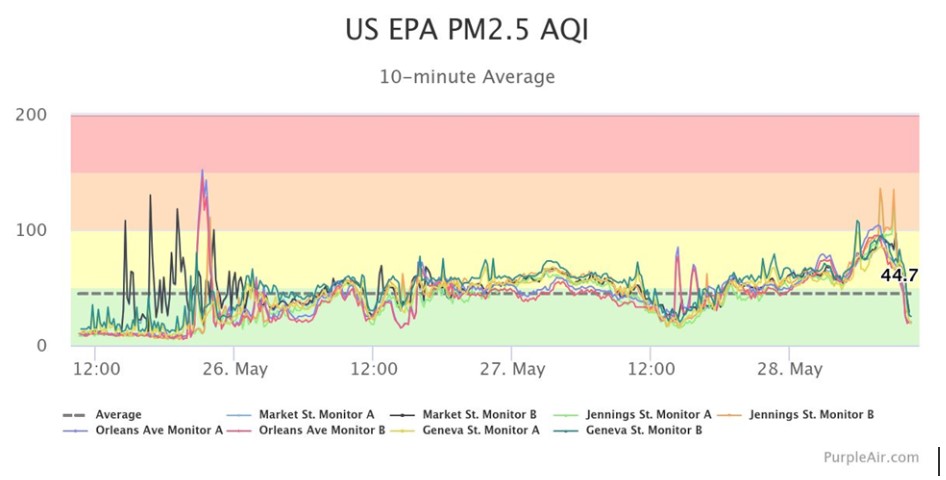Air Quality Monitoring Data Show Additional Steps Needed to Protect Public Health
posted
on Friday, June 13, 2025
in
Council News
Air Quality Monitoring Data Show Additional Steps Needed to Protect Public Health
Environmental Groups Call on Iowa DNR to Increase Monitoring Stations
Des Moines—Recent air quality monitoring data show exceedances of air quality standards, and the Iowa Department of Natural Resources (DNR) needs to increase its monitoring, according to comments from three environmental groups. The Iowa Environmental Council (IEC), Sierra Club, and Environmental Law & Policy Center (ELPC) submitted comments to the DNR highlighting air quality worse than federal standards and urging increased air monitoring stations, especially for large communities suffering from increased asthma rates.
The joint comments to the DNR highlight how Iowa’s current monitoring system found exceedances of ozone in May 2025, even with inadequate air monitoring stations. The Clean Air Act requires every state to monitor air quality to ensure that it meets public health standards. The monitoring network must detect air pollution such as ozone and fine particulate matter, or PM, that contribute to asthma and other health problems. Currently, Iowa’s Air Monitoring Network, operated by the Iowa DNR, is not designed to capture data from many of the areas with the highest concentrations of pollutants and asthma rates in Iowa, including areas near coal plants.
“Many areas with high asthma rates do not have nearby monitors, even though those are the people most at risk from poor air quality,” said Steve Guyer, Senior Energy Policy Counsel at the Iowa Environmental Council. “Iowa has a duty, both legally and morally, to monitor its air and protect public health. We urge the DNR to develop adequate monitoring to address at-risk populations — such as populations that experience high levels of environmentally related disease like asthma.”
A 2024 health report exploring the relationship between coal plant communities and asthma rates found that Woodbury County has the highest asthma rates in Iowa. MidAmerican Energy operates two coal plants in Woodbury County. However, Sioux City’s air quality monitors are not placed in a location near the coal plants emitting asthma-causing pollutants. A monitoring station north of Sioux City exceeded the eight-hour standard for ozone five times. Local monitoring stations installed for the Iowa Environmental Council showed a three-day average of 44.7 µg/m3, higher than the standard of 35 µg/m3.

“Children in Sioux City and across Iowa should be able to breathe easy whenever they go outside to play; unfortunately, air monitoring shows that’s not the reality families face throughout the state.” said Pamela Mackey Taylor, Director of the Iowa Chapter of Sierra Club. “Clearly what DNR is doing now is not enough, and they need to step it up. It shouldn’t be up to individuals to monitor the air. That’s DNR’s job.”
Across the state, 13 communities with at-risk populations (high asthma rates) have insufficient monitoring:
- Five communities have no monitoring for ozone or PM 2.5 (Ames, Burlington, Dubuque, Fort Dodge, and Ottumwa)
- Four communities have monitoring for either ozone or PM 2.5, but not the other (Council Bluffs, Iowa City, Waterloo, and Cedar Falls)
- Three communities have monitoring for both ozone and PM 2.5 (Cedar Rapids, Davenport, and Des Moines)
- Only one community has ozone and PM 2.5 monitors in the area of the at-risk population (Davenport)
“DNR can’t appropriately manage air pollution if it doesn’t adequately monitor it,” said Josh Mandelbaum, Senior Attorney for ELPC. “In many communities around the state, we clearly need more information. Poor air quality affects quality of life for many Iowans and their families. Air pollution doesn’t go away if DNR fails to monitor, it simply means DNR won’t know what actions it needs to take to keep our communities healthy and safe.”
Click here to read the full comment letter.
###
The Iowa Environmental Council is the state's largest and most comprehensive environmental alliance, comprised of diverse organizations and individuals working together to protect Iowa's natural environment. Through education, advocacy, and coalition-building, the Council raises awareness, generates action, and creates large-scale change. We work on federal, state, and local public policy issues to ensure a just, healthy environment and sustainable future for all Iowans.
The Sierra Club is America’s largest and most influential grassroots environmental organization, with more than 3.5 million members and supporters. In addition to protecting every person's right to get outdoors and access the healing power of nature, the Sierra Club works to promote clean energy, safeguard the health of our communities, protect wildlife, and preserve our remaining wild places through grassroots activism, public education, lobbying, and legal action.
The Environmental Law & Policy Center (ELPC) is the Midwest's leading public interest environmental legal advocacy organization. We develop strategic campaigns to protect natural resources and improve environmental quality. Our multi-disciplinary staff employs teamwork approaches using legal, economic, and public policy tools to produce successes that improve our environment and economy.